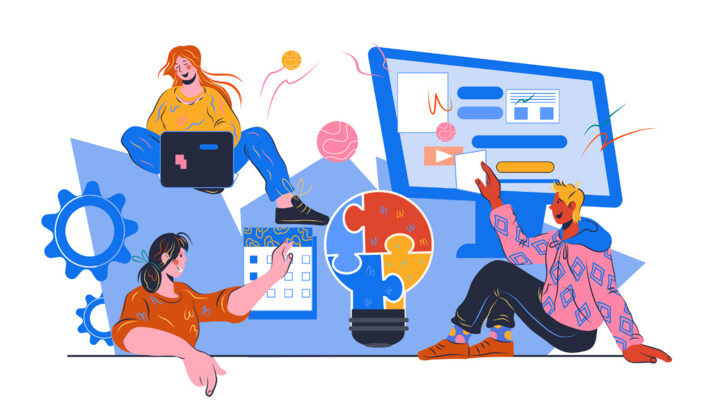Modern Workplaces: How to Thrive and Survive
Eilín Geraghty and Lars Steffen, eco Association, examine four interventions companies can take to build sustainable work models for the future.

© MariaGisina | istockphoto.com
In the world of work, major converging forces are ushering in the most significant disruption to workplaces since the industrial revolution. On the plus side, there’s innovative technology; on the downside, workplaces can be prey to elevated economic uncertainty, an aging population, deepening inequality, and climate change. While this might be nothing new for you to hear, what needs to be recognized is that not just employers and HR, but also present and future employees are looking for answers for big questions: Is the present work format slipping away? What will work look like in the future? What can employees expect from a modern workplace? And, ultimately, how will New Work trends affect the performance of staff and the success of the business?
Core interventions for modern workplaces
All of the clamor surrounding the sprawling issues can naturally be perturbing. But when we take a step back, we can identify concrete topics that all workplaces should consider: namely, the core interventions which would enable companies to not just survive, but also thrive.
To get down to brass tacks, four core interventions are required: embracing new technology, adopting agility to respond to continuous change, upgrading Diversity, Equity & Inclusion (DE&I) approaches, and building trust. While these concepts are obviously not new, they now need to be contemplated to a far greater degree and must be more upfront and solidified than ever before. Together, these are a ‘must’ for the creation of broad-based prosperity and sustainable work models for the future.
Intervention One: Embracing new technology
All modern workplaces have been spurred forward by the IT & tech industry, with advancements in technology enacting more and more changes throughout companies. It’s no surprise that, since the baby boom from the 1970s has started to peter out and led to increasing talent shortages, more and more companies are turning to technology to fill the gap. This is likely to have a significant impact on productivity, with the Bain’s Macro Trends Group, for example, anticipating a growth of around 30 percent productivity compared to 2015 levels. Nonetheless, while new technology might have some companies rubbing their hands together with glee, it must be said that many people are still inclined to approach it with scrutiny. This often comes down to a fear concerning potential sacrifices regarding perceived outdated work roles, or a sense of lower quality, efficiency, security or a lack of a ‘human touch.’
But luckily, there is a growing recognition of the clear pros over cons when it comes to incoming technology in the workplace, which can be regarded as going through three phases: innovation, adaptation, and stabilization. While the phases of innovation and adaptation can initially seem to throw things up in the air, companies are learning that such sacrifices are minor rather than major and can be quite quickly recouped after a company reaches the stabilization phase, and when staff members get to grips with how such technological tools enhances efficiency – and can actually make work far more enjoyable.
Let’s briefly look at just one of the multiple examples which have already reached the market stabilization phase, and which have helped to ‘save the day’: cloud technology. Given that sharing information manually and keeping track of files can be extremely time-consuming, two decades down the road, cloud technology has become a no-brainer when it comes to efficiency and quality. This method of storing data offsite that can be remotely accessed has quickly become a staple of everyday life, so much so that it is estimated that 85 percent of businesses worldwide use cloud technology to store their information.
Turning to new innovative technology: as we speak, ChatGPT is currently one of the most heated topics when it comes to workplace technology and is casting significant uncertainty regarding its down-the-road impact. For example, as a study from Sortlist reveals, 23 percent of employees working in the software and tech industry are worried about losing their jobs because of ChatGPT, while 43 percent of Millennials are worried during this innovation phase that it could take their own jobs.
For us – as the International Communication team at eco – the Association of the Internet Industry – this innovation phase rings a loud bell. Going back to 2017, a period when much of our work involved translation, we experienced similar worries when it came to the launch of DeepL Translator – a technology which translates texts using artificial neural networks. When DeepL first came on stream, things were a little up in the air regarding the impact on our translation work. But in our immediate decision to embrace this technology and ‘go with the flow,’ the benefits quickly became clear: since then, our work has evolved, with DeepL enabling us to save two-thirds of the time in our translation work – with post-editing being a crucial factor, as no technology can be ‘perfect’ without a human touch – and has since then freed up more time for us to engage in quality content generation. This made our communication work far more fun and creative.
In casting this insight towards the broader topic of ChatGPT, we can similarly see future workplaces which gain more creative capabilities. Such technology is not a step ahead of professionals, but is there to assist them, to be checked by them, and to allow opportunities to soar. Overall, it is clear that, in modern workplaces, both employers and employees must learn to grow more comfortable with the idea of replacing old systems with better ones. As we transition to this new world, we find that those who can embrace and adapt with the changes are those most likely to succeed. Ultimately, in embracing technology, what is therefore required is the adoption of agility in the workplace.
Intervention Two: Adopting agility
Agility is a mindset and way of working that enables teams to embrace innovative technology, leverage their unique skills, and deliver maximum value, even in a rapidly changing business environment. Overall, adopting agility enables companies to act quickly, improve the experience of their employees and their customers, and to deliver surpassing results. Research undertaken by PA Consulting has proven this. When they surveyed 500 leaders from some of the world’s largest organizations, they found that the top financial performers were 30 percent more likely to display agile characteristics.
As workplaces move forward, such agility is becoming more and more important. As a leading agility researcher, Ashutosch Muduli, states: “Agility is the most predominant solution to the problem of adapting to unpredictable, dynamic, and constantly changing business environments.”1 Rather than just feeling bound to adopt agility in times of emergency, such as in pandemic times, companies increasingly value how important agility is for thriving in an ongoing complex and changing business environment, where the technical structures are not fully known from the outset. Muduli makes a straightforward but compelling argument: if business leaders build agility into their company, they will make significant strides in preparing for the challenges and opportunities ahead.
Kevin Empey, a contemporary analyst of the future of work, argues that leadership agility is likely to be the most important competency for leaders today. For leaders, he recommends the following ‘4 Cs’ or habits:
| Providing clarity | Helping others to navigate complexity, reminding and energizing them about the “why” and purpose of what they are doing, framing and making sense of what is going on, and breaking complex situations down to the complicated or obvious. |
| Shaping culture | Reinforcing and role modelling the way things are done in the company, demonstrating and promoting agile values and behaviors such as collaboration, trust, and transparency, and prioritizing diversity. |
| Enabling change | Showing empathy, providing the necessary resources and support for people to do their work and make change happen. |
| Creating connection | Building relationships and trust, connecting at both the emotional and the rational level. |
Based on these ‘4 Cs,’ leaders get to empower their employees to develop multiple skill sets, take on new challenges, and continuously pursue emerging opportunities to expand their knowledge and collaborate cross-functionally. With leaders acting as the essential drivers for the realization of agility, the entire workforce gets to embrace more dynamic and fluid ways of working.
As Adesso notes, an absolute must for an agile team is the ingredient of resilience, which enables workers to deal with complexity and to use it as an opportunity to evolve. If a team is to build its resilience, it needs the leaders to build a safe environment on the strength of the ‘4 Cs,’ thereby allowing the team members to have a sense of autonomy and responsibility. To look this in the eye, we can hark back to our own experience as an International Communications team: When DeepL Translator came on board in 2017, the agile environment in which we worked helped us to deal with the changing work environment, while our personal resilience helped us to ‘seize the day.’ What’s more, as our team of four colleagues comprises women and men from three different countries, a further lesson can be picked up on here: an agile (and resilient) team benefits hugely from a wide range of perspectives accommodated by – you’ve guessed it – diversity.
Intervention Three: Prioritize Diversity, Equity & Inclusion (DE&I)
As already indicated, a core bedrock of agility is diversity, which automatically sweeps in a broader range of opinions, backgrounds, experiences, and areas of expertise to any workplace. A practical way to accomplish this is to include diversity, equity, and inclusion (DE&I) as a core part of a company’s culture. All in all, DE&I is a robust business case, with McKinsey’s 2020 report on ‘Diversity Wins,’ for example, showing that companies that are in the top quartile for ethnic diversity on executive teams are 36 percent more likely to have above-average profitability than companies in the fourth quartile.
For IT & tech companies in particular, prioritizing DE&I is an absolute must. In this context, it is not just about reaching the core goal of an agile culture, but is also about accessing sufficient levels of talent. While the current spate of layoffs due to economic uncertainties may be causing IT & tech companies to rethink skills shortages, this gap is not set to close: as pointed out by a 2021 McKinsey analysis, a tech talent gap of 1.4 million to 3.9 million is forecast by 2027 for EU-27 countries. Employers across the globe (and particularly in developed economies) urgently need more workers in order to address the ongoing skills gap.
In reviewing the IT & tech industry, what is particularly clear is that the greatest untapped pool of talent is that of women. But unfortunately, in spite of the indisputable need to have far more women involved in IT & tech careers, the gender imbalance in the industry still remains far more stagnant than mobile. In the US, for example, the most recent statistics show that just over one in four (26.7 percent) professionals in tech are female, while in Europe, the most recent Eurostat figures show that the proportion of women is less than one in five (19.1 percent). In this regard, a central issue to recognize is that gender imbalance in the tech field does not just suddenly surface at a time when young women start their careers. Rather, career expectations are molded at a very early stage in life and become further entrenched as girls grow up.
To build the agility and sustainability of IT & tech workplaces, action is required from several sources. Number 1: When it comes to businesses, a key to success for IT & tech companies is a carefully developed Gender Equality Strategy overseen by the agile leaders as part of the DE&I company culture. Four key policies that should be built into such a strategy are spelt out in the eco Association’s 2020 study on Women in Tech Across the Globe: A Good Practice Guide for Companies. These policies include:
i) Recruitment & on-ramping of women
ii) Retention of women through New Work culture
iii) Supporting women to rise up the ranks
iv) Collaboration with education providers to build the pipeline of female talent
Naturally, multiple actions are associated with these policies, such as ensuring the workplace is free of gender bias (even unconscious bias), building an inclusive culture, addressing pay equity, creating flexible work arrangements, and setting metrics to hold leaders accountable.
But it is also evident that boosting diversity in future IT & tech workplaces requires not just work by companies themselves, but also calls for critical input by society as a whole. For policymakers and educators, six guidelines are proposed in the eco Association’s 2022 White Paper on “Girls in Tech: A Call to Action,” ranging from actions in kindergartens and schools all the way up to higher education, with mentoring in all digital spheres – particularly at the college level – considered to be of particular value. Likewise, an argument in a recent 2023 McKinsey paper on “Women in tech: The best bet to solve Europe’s talent shortage” indicates that programs supporting women already in university STEM classes can have the best impact.
Intervention Four: Building Trust
For diversity to flourish in any workplace, mutual respect and appreciation are imperative. Employees who are genuinely listened to, recognized, and motivated are far more likely to join and stay with a company. By attracting and retaining more women, for example, companies can gain more trust, as emphasized by Lucia Falkenberg, CPO of the eco Association and DE-CIX. This brings us nicely to the fourth intervention: Internally in the modern workplace, building trust is a key factor for ultimate survival.
In his article “The Neuroscience of Trust,” Prof. Paul Zak from the Claremont University writes how, compared with people at low-trust companies, people at high-trust companies have reported the following: 74 percent less stress, 106 percent more energy at work, and 50 percent higher productivity. To form such high-level trust, an essential mechanism is that of empathetic leadership: this not only serves the individual colleagues from all backgrounds, but the entire business, as it helps each person to understand their value in the workplace and how their growth can be aligned with the company. To cultivate such trust, Zak notes how leaders must set a clear direction, give people what they need to see it through and, subsequently, ‘get out of their way.’ In this fashion, high-trust companies hold people accountable but without micromanaging them: namely, they treat people like responsible adults.
If you’re part of a such a high-trust company, you might naturally think that everything’s already ‘in the bag.’ But the reality is, as we move into the future, building trust internally within a company is by no means the be-all and end-all for a future-proof workplace. As more and more companies enter into ecosystems, they must also engage regularly in external collaboration – and build trust with stakeholders in these ecosystems. As cited by Andreas Weiss, Director of Digital Business Models at eco and Director of EuroCloud Deutschland, “it is necessary for companies to find their niche within the interconnected ecosystem, establish a new network of partnerships, and learn to collaborate with competitors.” Weiss notes that the cloud, in particular, acts as the foundation for trustworthy collaborative approaches. To build trust in ecosystems, what is deemed to be essential is appropriate security and compliance management: In this regard, digital identity is one of the key factors for maintaining such security.
Looking outwards, workplaces must naturally also build and retain customer trust. When it comes to the fields of software and IT security solutions, this is of particular relevance. With the exponential spread of technology, digital assets require a specific level of protection, but it is no longer easy for users to effectively verify this protection. As Prof. Norbert Pohlmann from the eco Association elucidates, users have few alternatives but to trust that manufacturers are doing everything they can to meet the requirements. Looked at from the other perspective: Manufacturers depend on users to trust them and to actually use their IT/security solutions. For a manufacturer to be able to transfer trust to its IT solution in a dedicated manner, Prof. Pohlmann identifies three factors, alongside cybersecurity, that also play a relevant role: transparency, performance, and conciseness of purpose.
All in all, to build the degree of trust required in modern workplaces, all leaders and all colleagues need to have the proper mindset to lay the foundation for trust. To come full circle: the interventions that have been highlighted throughout this article are the key foundations for making trust tick.
Interventions must go hand in hand
While embracing technology might be seen by IT & tech companies as a piece of cake, and building trust is a clear prerequisite, the two interconnected interventions – agility and DE&I – are two key concepts that must also go hand in hand. It’s thus unfortunate to learn that those focusing on agility often ignore DE&I, which is made clear by research from the Business Agility Institute. The reality is that companies not acting to center DE&I in their agile ways of working miss out on unique opportunities. But, on the flip side, companies that embed DE&I directly into their agile transformations seriously outperform those companies that don’t.
For any company out there with potential skills shortages and questions regarding their future workplaces, the four interventions spelt out above should therefore be joined at the hip – and are those which would enable companies to not just survive, but also to thrive.
1 Muduli, A. (2016). Exploring the facilitators and mediators of workforce agility: An empirical study, Management Research Review, Vol.39(12)
Eilín Geraghty is Project Manager in the eco International team at eco - Association of the Internet Industry. Before joining eco in 2017, Eilín worked for over two decades as a manager, a consultant, and a lecturer - with the common thread running through her career being a focus on inclusion and equality.
Lars Steffen is Director International at eco – Association of the Internet Industry (international.eco.de), the largest Internet industry association in Europe. At eco, he coordinates all international activities of the association and takes care of the members from the domain name industry.






